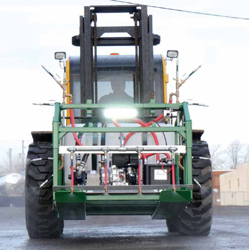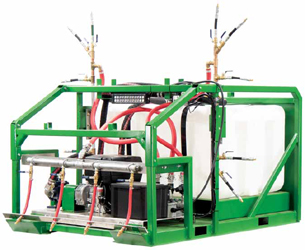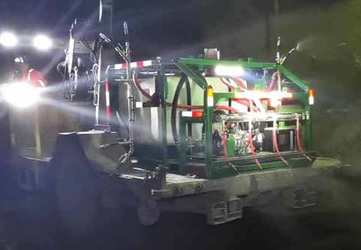
A miner uses a specially design system to apply a dust control
product to the road, rib walls and the back
Suppressing Underground Dust and its Related Costs
Purpose-built system applies a dust control formula specifically designed
for underground mines
By Steve Fiscor, Editor-in-Chief

The frequency of application can also impact an operation. If the product application is too light, it will usually need to be reapplied. If it is too heavy, the conditions could become greasy or slippery, which leads to another set of safety-related issues. If the product has a strong binder, it could create a crust on which more dust just accumulates. Recently, an underground metal mining operation in the western U.S. was experiencing dust issues related to the haulage level and its decline, which served as the main intake for ventilation. Once they decided to attack the problem by grading and applying product, the conditions deteriorated to the point where they found themselves rebuilding the main haulage roadway every three days. Frustrated, they reached out for help and engaged a chemical manufacturer that not only designed a product for underground use, but also created a system to apply it, which solved several problems. The mine’s working conditions and productivity performance improved to the extent that several other underground mining operations are now using the system.
Dealing With Underground
Dust
The mine uses a caving method to produce
ore. The caving action crushes the
ore and loaders (LHDs) remove the ore
from draw points and haul it to the ore
passes where they dump the load. The
ore passes feed haulage chutes, which
are used to load 80-ton trucks. All this
activity — cave generation and development,
mucking at draw points on the production
level, and opening the haulage
chutes to load the trucks — creates dust.
On top of that, the mine was moving
more than 1.7 million cubic feet per minute
of air to ventilate the operation. The
air moving through the mine had a relatively
high velocity and low humidity. Any
dust created on the main intake traveled
to the production level. The production
level was generating considerable dust.
All the dust generated would circulate
throughout the mine.
The low humidity inhibited the use of water alone as a wetting agent. The mine was using lignosulfonates to control the dust and conditions were not improving, said Colin Shaw, project manager and senior mining engineer for Nordmin USA, who worked for the mine at the time and was directly involved with the dust control program. Lignosulfonates are basically glue created from tree sap, a byproduct of the paper manufacturing business. The mine’s dust control program consisted of multiple water trucks with dedicated operators. One was assigned to the development crew and it focused on the access ramps and new areas. Another was assigned to the production level and a third unit operated with the haulage team at the bottom level with the crusher. Not knowing the mine well, the junior miners operating the water trucks were often unsure where they were needed most.

“Controlling the dust on the main access roads was easy enough if the road was reasonably well-graded and the product was not running off,” Shaw said. “The haulage road was a different story. You could grade the road all you wanted, and they did every three days, but those 80-ton trucks would just beat that road up. Every three days, the mine would shut down the haulage road, regrade, reconstruct and rebuild it, and that process kicked up more dust. Water was worse and it would just turn the road into mud. “We needed a product that would help build the road in a way that would last longer than three days,” Shaw said. “A product that would lock down the dust and, if possible, absorb more dust as it accumulated.” He reached out to Midwest Industrial Supply.
Like many underground mines, they were using run-of-mine fines and muck from old draw points as road base. “We needed a product that would bind, but not over-bind, like the lignosulfonate, and remain moist enough to absorb more dust,” Shaw said. “It had to be strong enough to support the 80-ton, fully-loaded trucks yet wet enough to absorb any dust coming off the trucks. If it stayed moist enough, then any ambient dust from the trucks would stick.” The object was to reduce watering times and extend the number of days until the next road rebuild. “Productivity would improve because the entire crew was performing road reconstruction work every three days and those hours add up,” Shaw said.
After implementing Midwest Industrial Supply’s proprietary MineKleen Underground Mine Dust Control System, the goal was to push the time between road rebuilds from three days to 11 days. The primary crusher had preventive maintenance (PM) scheduled every two weeks. Production would run for 11 days and they would use the remaining three days for crusher PM on a two-week schedule. “We needed that road to last 11 days,” Shaw said.
They implemented a new dust control strategy and started using the MineKleen Plus formulation, which did not lock everything up and remained moist. They replaced the junior miners operating the water trucks with a senior miner that knew the mine and had the construction skills. “When an area had dust problems, he was there within 30 minutes, putting product down,” Shaw said. “He basically built a routine around the mining activities taking place. Every two weeks, he was able to cover the entire mine and eventually took over the responsibilities from the other water truck drivers.”
At first, they pushed the road rebuild from three to five days, moving cautiously, then seven days. They did not really believe they could get to 11 days, but they did after about 2.5 months, Shaw explained. “We probably could have ramped up more quickly, but miners are conservative in nature and they wanted to do it in smaller increments,” Shaw said. The company understood that the more the trucks ran, it would be easier to meet production bonuses. They eventually hit a couple of single-day records for ore trucked to the crusher. They didn’t have to rebuild the roads as frequently and the crush-convey team was setting daily production records. Ownership of the problem was a big deal and the entire team participated.

“The labor efficiencies of maintaining the road during the PM played a significant role in the cost reduction,” Shaw said. “More importantly, the crew of six to eight miners that would have been rebuilding the road three times during that two-week span were now completing productivity- related projects. We wasted a lot of hours constantly rebuilding the roads. “Midwest Industrial came to us with a solution rather than just simply trying to sell us product,” Shaw said. He estimated that, once they got the product and the application system on-site, the problem was solved in 2.5 months.
Understanding the Problem
Lynn Edwards, senior sales representative
for Midwest Industrial Supply, made
the initial assessment and oversaw the
work of implementing the new system.
“The real challenge here was the underground
aspect,” Edwards said. “I felt we
could solve the problem. In addition to
the dust, they had a stabilization problem.
That lack of stability was creating a
lot of extra work with the constant roadway
regrading efforts.”
After three or four visits to the mine,
Edwards proposed the MineKleen Plus
formulation, which has a binder. “It’s important
to see the situation firsthand and
understand the problems and the challenges
these miners were dealing with,”
Edwards said. “Unlike lignosulfonate,
MineKleen was not a water-soluble product,
so they would not need to spray nearly
as much of it and nowhere near as often.”
Many dust control programs rely on
the frequency of application, not so much
on sheer volume of application, Edwards
explained. “In this case, we didn’t want
to tie up traffic while we were applying
the product,” Edwards said. “We needed
the binder to do its thing quickly.”
Rain or water is usually the enemy of
most dust control programs, so he knew
they had an advantage in this situation.
The trucks, however, were relentless. “The
path is the path underground, 24/7,” Edwards
said. “With open-pit applications,
the trucks move around quite a bit. We
were pleased to see how the product held
up under load.”
The MineKleen Sprayer was designed in a way that miners could shove it off the back of a truck and push it around with an LHD. “It’s a simple system that has been built for the mining environment,” Edwards said. “Unless they run over it, it should work well in any underground mine.” The applicator consists of a small diesel engine, a gear box, a positive displacement pump, a few solenoids and nozzles (sprays). When it came to training the miners on how to use the system, Edwards said the most difficult thing was getting them to look in the mirror. He would encourage them to remember what they were doing. “How does it look as you’re applying it?” Edwards asked. “It’s a fine line. Too much could make the surface slippery. Under-applying it means they have to make another pass. We had to train the operator’s eye. Once you over apply it, you cannot undo it.”
The MineKleen formulations are non-toxic, non-corrosive and non-hazardous. “It can sit for months at -10°F and still spray,” Edwards said. “Other products would become more viscous.” The beauty of the MineKleen formulations is the shelf life. “Because it’s not a water-soluble product, it can be stored indefinitely,” Edwards said. “Temperature has no real effect on it. They spray with the machine. They park it and forget about it for two weeks. They do not have to worry about something hardening and plugging the system. It’s very user friendly and requires very little maintenance.”
Developing a System
Approach
With a win under their belt, Midwest Industrial
Supply began to re-evaluate the
underground market. Dan Carpenter, senior
technical sales and application specialist
for Midwest, took what they had
learned from the first experience and developed
the full system they now have in
use at five underground mines in the U.S.
and Canada.
“It really was surprising how the
underground environment differs from
above ground,” Carpenter said. “The
ventilation system creates this constant
wind that carries dust throughout
the mine.”
Carpenter is credited with developing
the MineKleen Underground Mine Dust
Control System. “Midwest Industrial Supply
is a chemical manufacturer,” Carpenter
said. “You can have the best chemical
in the world, but if it’s not properly applied,
it won’t work well.”
Midwest has always designed application systems. When they first started in the dust control business, most of the products were water-based products that would be mixed and applied with a water truck. “Back then, the biggest change was converting from a fan spray nozzle to a spray bar,” Carpenter said. “Then we moved into synthetic and organic mixtures, which are not water-based, and we developed the E-sprayer, the first version of the MineKleen Sprayer application equipment.” Carpenter spent considerable time underground working with miners to develop the system from a prototype to today’s more sophisticated version. “We toughened it up to military-grade standards,” Carpenter said. “Once we understood the problem, it was just a matter of modifying the sprayer for the underground environment.”

When a mine purchases the MineKleen Underground Dust Control System, they get the MineKleen dust control formulation, the MineKleen Sprayer application equipment and training. A manual and DVD are shipped with the system. “The video covers everything from opening the crate to applying the product to maintaining the equipment,” Carpenter said. It’s difficult to get underground these days for the training and Midwest Industrial Supply has found a way around that logistically. The whole unit will fit into a cage. The product comes in bulk or in 275-gallon totes. “We built the sprayer as big as we could but kept it small enough to fit inside the cage,” Carpenter said.
He credited the improvements to the voice of the customer. “It’s nice to have people who give feedback,” Carpenter said. Underground miners have tried dust control products that were designed for surface applications and a lot of them have just not worked well, Carpenter explained. “Some of these products will actually accelerate mold growth underground,” he stated. “The mines that have mold are very sensitive to it. The MineKleen product has a mold inhibitor. We took samples of the mold underground and analyzed it in our labs to determine what additive was needed to control it. We modified the formula and solved that problem, too.” “This system has been beneficial for everyone,” Carpenter said. “We have received a lot of positive feedback.” Midwest Industrial has implemented five MineKleen systems in underground mines during the first 12 months of the program.